Evolution
Change
A __________ includes all living and non-living things in an environment.
A. population
B. niche
C. abitotic
D. ecosystem
D. ecosystem
Evolution can best be described as
The change in size of body structures through use and disuse
The formation of fossils
A process of growth in an organism
A process of change through time
4. A process of change through time
Which statement is not part of the concept of natural selection?
(1) Individuals that possess the most favorable variations will have the best chance of reproducing.
(2) Variation occurs among individuals in a population
(3) More individuals are produced than will survive.
(4) Genes of an individual adapt to a changing environment.
(4) Genes of an individual adapt to a changing environment.
Which two species are the most closely related?
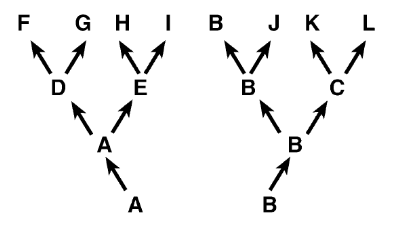
J and L
G and L
F and H
F and G
4. F and G
A change in the acidity of mountain lakes would most likely be a result of
A. ecological succession of the area at the top of the mountain
B. the introduction of new species into the lakes
C. air pollution from smoke stacks miles away
D. planting grasses and shrubs around the lakes
C. air pollution from smoke stacks miles away
Which statement illustrates a biotic resource interacting with an abiotic resource?
A rock moves during an earthquake
A sea turtle transports a pilot fish to food
A plant absorbs sunlight, which is used for photosynthesis
Wind cause waves to form on a lake
3. A plant absorbs sunlight, which is used for photosynthesis
The different tools used during the beaks of the finches lab represented
Feeding adaptations in finches
Nest construction adaptations
Variations in seed size
Variations in ecosystems
1. Feeding adaptations in finches
A certain species has little genetic variation. What would the rapid extinction of this species most likely result from the effect of?
Successful cloning
Gene manipulation
Environmental change
Genetic recombination
3. Environmental change
2. The diagram below illustrates a proposed evolutionary path of certain organisms, based on the theory of evolution. Which statement could best be inferred from the information in this diagram?
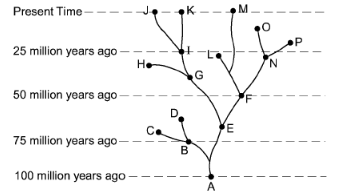
Evolution does not involve gradual change
Evolutionary changes can result in extinction
Evolution begins with plants
Evolution produces organisms that all fill the same niche
2. Evolutionary changes can result in extinction
Continued depletion of the ozone layer will most likely result in
A. an increase in skin cancer among humans
B. a decrease in atmospheric pollutants
C. an increase in marine ecosystem stability
D. a decrease in climatic changes
A. an increase in skin cancer among humans
In 1960, an invasive species of fish was introduced into the stable ecosystem of a river. Since then, the population of a native fish species has declined. This situation is an example of an
A. ecosystem that has recovered
B. ecosystem altered through the activities of an organism
C. environmental impact caused by physical factors
D. ecological niche without competition
B. ecosystem altered through the activities of an organism
When antibiotics were first developed, most infectious diseases could be controlled by them. Today, certain bacteria are resistant to many antibiotics. One possible explanation for this change is
(1) the antibiotics killed most of the bacteria that did not have a genetic variation for resistance
(2) the bacteria needed to change in order to produce more antibiotics
(3) some of the bacteria learned how to resist the antibiotics
(4) antibiotics have become weaker over the years
(1) the antibiotics killed most of the bacteria that did not have a genetic variation for resistance
Which statement provides evidence that evolution is still occurring at the present time?
The extinction rate of species has decreased in the last 50 years
Many bird species and some butterfly species make annual migrations
New varieties of plant species appear more frequently in regions undergoing climatic change
Through cloning, the genetic makeup of organisms can be predicted
3. New varieties of plant species appear more frequently in regions undergoing climatic change
The kit fox and red fox species are closely related. The kit fox lives in the desert, while the red fox inhabits forests. Ear size and fur color are two differences that can be observed between the species. An illustration of these two species is shown below. Which statement best explains how the difference between these two species came about?
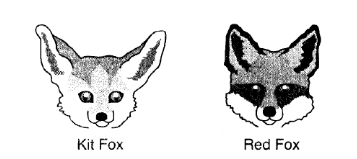
Different adaptations developed because the kit fox preferred hotter environments than the red fox.
As the foxes adapted to different environments, differences in appearance evolved
The foxes evolved differently to prevent overpopulation of the forest habitat
The foxes evolved differently because their ancestors were trying to avoid competition.
2. As the foxes adapted to different environments, differences in appearance evolved
Which environmental concern is most associated with burning fossil fuels?
Global climate change
Pollution of ocean waters
Ozone layer destruction
Decrease in levels of atmospheric carbon dioxide
1. Global climate change
What is one irreversible effect of both deforestation and water pollution on the environment?
Extinction of species
Thinning of the ozone shield
Depletion of atmospheric carbon dioxide levels
Increase in renewable resources
2. Thinning of the ozone shield
Which concept is represented in the graph below?
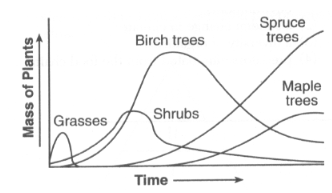
Ecological succession in a community
Cycling of carbon and nitrogen in a forest
Energy flow in a food chain over time
Negative human impact on the environment
1. Ecological succession in a community
The evolution of new insect populations that are resistant to chemical insecticides illustrates
Biological control
Use and disuse
Natural selection
Low survival value
3. Natural selection
Which two species would most likely show the greatest similarity of DNA and proteins?
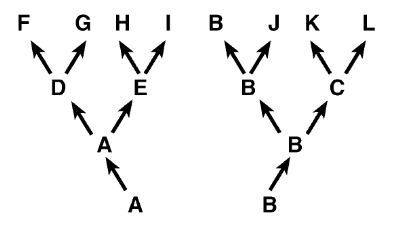
B and J
G and I
J and K
F and L
1. B and J
One advantage of biodiversity in an ecosystem is that it
A. guarantees that the largest organisms will dominate the area
B. ensures a large amount of identical genetic material
C. develops relationships between organisms that are always positive over long periods of time
D. increases the chance that some organisms will survive a major change in the environment
D. increases the chance that some organisms will survive a major change in the environment
Which list includes only abiotic factors?
A) soil, water, air, and sunlight
B) ducks, fish, soil, and water
C) humidity, temperature, rodents, and grasses
D) trees, flowering plants, mosses, and ferns
A) soil, water, air, and sunlight
Communities have attempted to control the size of mosquito populations to prevent the spread of certain diseases such as malaria and encephalitis. Which control method is most likely to cause the least ecological damage?
A. draining the swamps where mosquitoes breed
B. spraying swamps with chemical pesticides to kill mosquitoes
C. spraying oil over swamps to suffocate mosquito larvae
D. increasing populations of native fish that feed on mosquito larvae in the swamps
D. increasing populations of native fish that feed on mosquito larvae in the swamps
This diagram represents the relationship between break structure and food in several species of finches in the Galapagos Islands. Which factor most directly influenced the evolution of the diverse types of beaks of these finches?

Predation by humans
Available food sources
Oceanic storms
Lack of available niches
2. Available food sources
Which species was best adapted to changes that occurred in its environment over the longest period of time?

A
B
C
J
2. B
6. Human impact on the environment is often more dramatic than the impact of most other living things because humans have a greater
Need for water
Need for food
Ability to adapt to change
Ability to alter the environment
4. Ability to alter the environment